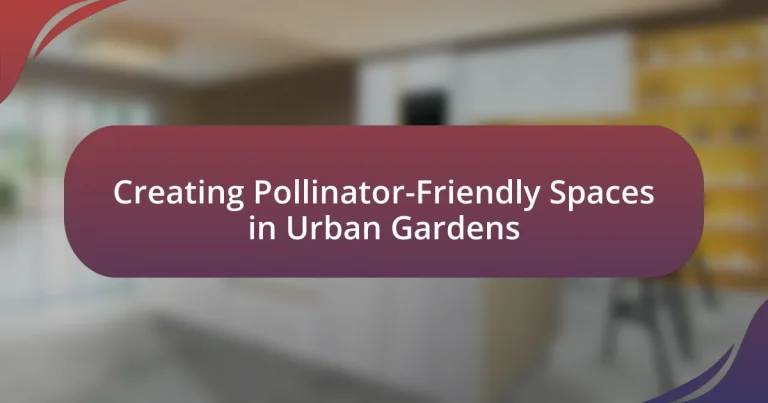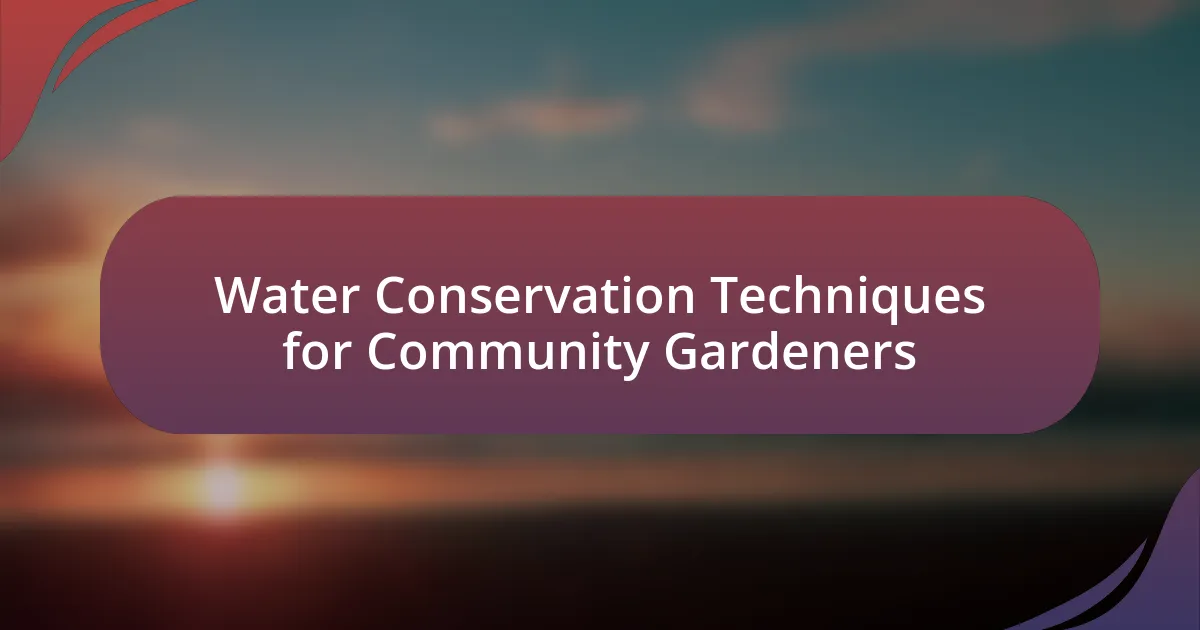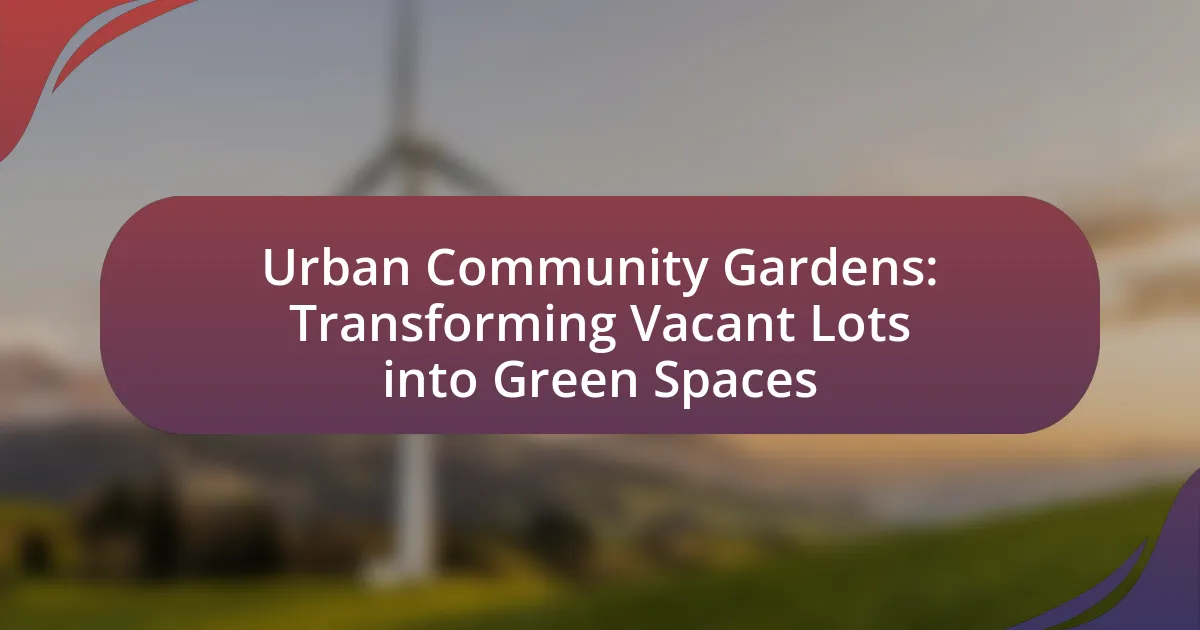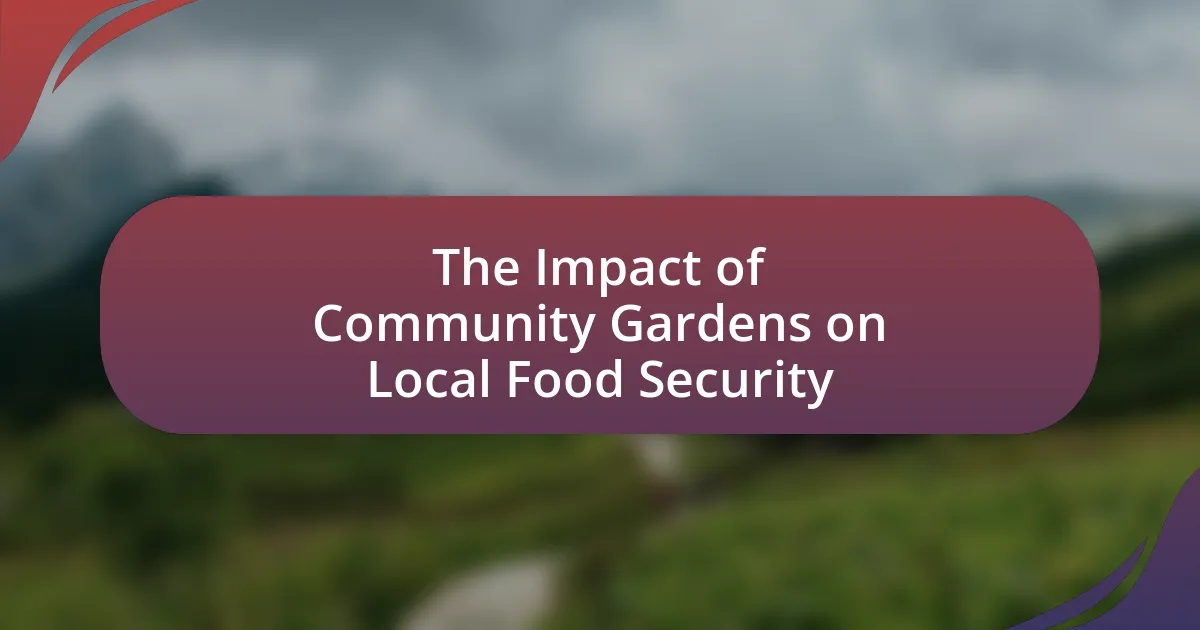Creating pollinator-friendly spaces in urban gardens involves establishing areas that provide essential habitats and resources for pollinators such as bees and butterflies. These spaces are characterized by diverse native flowering plants, water sources, and shelter, which collectively enhance local biodiversity and ecosystem health. Pollinators play a critical role in food production, as approximately 75% of the world’s food crops rely on their activities for reproduction. The article explores the importance of pollinators, the characteristics of effective pollinator-friendly gardens, the challenges faced in urban environments, and practical steps for gardeners to support pollinator populations through thoughtful design and maintenance practices. Additionally, it highlights resources and organizations that assist urban gardeners in creating these vital habitats.

What are Pollinator-Friendly Spaces in Urban Gardens?
Pollinator-friendly spaces in urban gardens are designated areas that provide essential habitats and resources for pollinators, such as bees, butterflies, and other insects. These spaces typically include a variety of native flowering plants that offer nectar and pollen, as well as features like water sources, shelter, and nesting sites. Research indicates that urban gardens with diverse plant species can significantly enhance local pollinator populations, contributing to biodiversity and ecosystem health. For instance, a study published in the journal “Ecological Applications” found that urban gardens with native plants support higher densities of pollinators compared to those with non-native species.
Why are Pollinators Important for Urban Gardens?
Pollinators are crucial for urban gardens because they facilitate the reproduction of flowering plants, which is essential for food production and biodiversity. In urban environments, where natural habitats are often limited, pollinators such as bees, butterflies, and birds help to ensure that plants can produce fruits and seeds. Research indicates that approximately 75% of the world’s food crops depend on animal pollination, highlighting the vital role pollinators play in sustaining urban agriculture and enhancing ecosystem health. By supporting pollinator populations, urban gardens can contribute to food security and promote a diverse range of plant species, ultimately benefiting both the environment and local communities.
What roles do pollinators play in urban ecosystems?
Pollinators play a crucial role in urban ecosystems by facilitating the reproduction of flowering plants, which enhances biodiversity and supports food production. Their activities contribute to the pollination of approximately 75% of the world’s flowering plants, including many crops that are vital for human consumption. In urban areas, pollinators such as bees, butterflies, and birds help maintain green spaces and contribute to the overall health of the ecosystem by promoting plant growth and diversity. This, in turn, supports other wildlife and improves air quality, making cities more livable.
How do pollinators contribute to food production in cities?
Pollinators significantly enhance food production in cities by facilitating the reproduction of flowering plants, which are essential for fruit and vegetable crops. Specifically, bees, butterflies, and other pollinators transfer pollen from male to female flower parts, leading to fertilization and the development of seeds and fruits. Research indicates that approximately 75% of the world’s food crops depend on animal pollination, highlighting the critical role pollinators play in urban agriculture. In cities, where green spaces are limited, creating pollinator-friendly environments can increase biodiversity and improve crop yields, thereby supporting local food systems and enhancing food security.
What Characteristics Define Pollinator-Friendly Spaces?
Pollinator-friendly spaces are characterized by diverse plant species, native flora, and continuous blooming periods. These spaces support a variety of pollinators, including bees, butterflies, and hummingbirds, by providing essential food sources and habitats. Research indicates that gardens with at least 30% native plants can significantly increase pollinator visits, as native species are more adapted to local pollinators’ needs. Additionally, incorporating features such as water sources, shelter, and minimal pesticide use further enhances the suitability of these environments for pollinators.
What types of plants attract pollinators?
Plants that attract pollinators include flowering species such as lavender, sunflowers, and coneflowers. These plants provide nectar and pollen, which are essential food sources for bees, butterflies, and other pollinators. Research indicates that native plants, like milkweed and black-eyed Susans, are particularly effective in attracting local pollinator species due to their co-evolution with these insects. Additionally, plants with varied bloom times ensure a continuous food supply throughout the growing season, further enhancing their attractiveness to pollinators.
How does garden design influence pollinator activity?
Garden design significantly influences pollinator activity by providing essential resources such as food, shelter, and nesting sites. Well-planned gardens that incorporate a diverse range of flowering plants can attract various pollinators, including bees, butterflies, and hummingbirds, which rely on these plants for nectar and pollen. Research indicates that gardens with native plants enhance pollinator diversity and abundance, as native species are better adapted to local ecosystems and provide the necessary resources for local pollinator populations. For instance, a study published in the journal “Ecological Applications” found that urban gardens with a higher diversity of native flowering plants supported 50% more pollinator species compared to those with non-native or limited plant diversity. This evidence underscores the critical role of garden design in fostering healthy pollinator communities.
What Challenges Do Urban Gardens Face in Supporting Pollinators?
Urban gardens face several challenges in supporting pollinators, primarily due to limited space, habitat fragmentation, and pesticide use. Limited space restricts the variety and abundance of flowering plants that can be cultivated, which are essential for attracting and sustaining pollinator populations. Habitat fragmentation occurs when urban development isolates green spaces, making it difficult for pollinators to navigate between food sources and nesting sites. Additionally, the use of pesticides in urban gardening can harm pollinator health, reducing their populations and effectiveness in pollination. These factors collectively hinder the ability of urban gardens to create conducive environments for pollinators.
How does urbanization impact pollinator populations?
Urbanization negatively impacts pollinator populations by reducing their habitats and food sources. As cities expand, natural landscapes are replaced with impervious surfaces, leading to habitat fragmentation and loss. Research indicates that urban areas often have fewer flowering plants, which are essential for pollinators like bees and butterflies. A study published in “Ecological Applications” by McFrederick and LeBuhn (2006) found that urbanization can decrease bee diversity by up to 30% compared to rural areas. Additionally, increased pesticide use in urban settings further threatens pollinator health, contributing to population declines.
What are common threats to pollinators in urban environments?
Common threats to pollinators in urban environments include habitat loss, pesticide use, pollution, and climate change. Habitat loss occurs due to urban development, which reduces the availability of flowering plants and nesting sites essential for pollinators. Pesticide use, particularly neonicotinoids, has been shown to harm bee populations by impairing their foraging behavior and reproduction. Pollution, including air and water contaminants, can negatively affect pollinator health and food sources. Climate change alters flowering times and disrupts the synchrony between pollinators and plants, further threatening their survival. These factors collectively contribute to the decline of pollinator populations in urban settings.
How Can We Create Pollinator-Friendly Spaces in Urban Gardens?
To create pollinator-friendly spaces in urban gardens, incorporate a diverse range of native flowering plants that bloom at different times throughout the growing season. This diversity ensures a continuous food source for pollinators such as bees, butterflies, and hummingbirds. Research indicates that native plants are more beneficial to local pollinator populations because they provide the specific nectar and pollen that these species have evolved to utilize effectively. For example, a study published in the journal “Ecological Applications” found that gardens with a higher diversity of native plants supported significantly more pollinator species compared to those with non-native or fewer plant varieties. Additionally, avoid using pesticides and herbicides, as these chemicals can harm pollinators. Creating habitats such as bee hotels, leaving bare patches of soil for ground-nesting bees, and providing water sources can further enhance the garden’s appeal to pollinators.
What steps can be taken to design a pollinator-friendly garden?
To design a pollinator-friendly garden, select a diverse range of native flowering plants that bloom at different times throughout the growing season. This diversity ensures that pollinators have a continuous food source. Additionally, avoid using pesticides, as they can harm beneficial insects. Incorporating features such as water sources, nesting sites, and shelter can further support pollinator populations. Research indicates that gardens with native plants attract more pollinators, enhancing biodiversity and ecosystem health. For example, a study published in the journal “Ecological Applications” found that native plant gardens significantly increased the abundance and diversity of pollinators compared to non-native plant gardens.
How can community involvement enhance pollinator habitats?
Community involvement can enhance pollinator habitats by fostering collaborative efforts to create and maintain diverse, native plant gardens that support pollinator populations. Engaging local residents in planting native flowers, reducing pesticide use, and establishing community gardens increases the availability of food sources and nesting sites for pollinators. Research indicates that urban areas with community-managed green spaces show higher biodiversity, including pollinators, due to the variety of plants cultivated and the reduced fragmentation of habitats. For instance, a study published in the journal “Ecological Applications” found that community gardens significantly contribute to urban biodiversity, providing essential resources for pollinators.
What Maintenance Practices Support Pollinator-Friendly Gardens?
Maintenance practices that support pollinator-friendly gardens include minimizing pesticide use, providing diverse plant species, and ensuring continuous blooming throughout the growing season. Minimizing pesticide use is crucial because many chemicals can harm pollinators; studies show that neonicotinoids, for example, have been linked to declines in bee populations. Providing diverse plant species attracts a variety of pollinators, as different species prefer different types of flowers; research indicates that gardens with at least 10 different flowering plants can support a wider range of pollinator species. Ensuring continuous blooming throughout the growing season helps provide a consistent food source for pollinators, as many species rely on specific plants during different times of the year.
How often should pollinator gardens be maintained?
Pollinator gardens should be maintained at least once a month during the growing season. Regular maintenance includes tasks such as weeding, deadheading spent flowers, and checking for pests. Research indicates that consistent upkeep enhances the health and productivity of the garden, which in turn supports local pollinator populations. For example, a study published in the journal “Ecological Applications” highlights that well-maintained gardens provide better habitats for pollinators, leading to increased biodiversity and ecosystem resilience.
What are the best practices for pest management in these gardens?
The best practices for pest management in urban gardens focused on creating pollinator-friendly spaces include integrated pest management (IPM), promoting biodiversity, and using organic pest control methods. IPM combines monitoring pest populations, identifying pests accurately, and implementing control measures only when necessary, which minimizes harm to beneficial insects. Promoting biodiversity by planting a variety of native plants attracts natural predators of pests, reducing pest populations naturally. Additionally, using organic methods such as neem oil or insecticidal soap effectively controls pests while being safe for pollinators. These practices are supported by research indicating that diverse plantings and reduced chemical use enhance ecosystem health and pollinator populations.
What Resources Are Available for Urban Gardeners?
Urban gardeners have access to a variety of resources that support their gardening efforts, particularly in creating pollinator-friendly spaces. These resources include local community gardens, gardening workshops, online platforms like the American Community Gardening Association, and educational materials from organizations such as the Pollinator Partnership. Community gardens provide shared spaces and resources, while workshops offer hands-on learning experiences. Online platforms facilitate networking and information sharing among urban gardeners. Educational materials often include guidelines on plant selection and habitat creation, which are essential for attracting and sustaining pollinators.
Where can gardeners find native plant lists for pollinators?
Gardeners can find native plant lists for pollinators through resources such as the Native Plant Society of North America, which provides comprehensive lists tailored to specific regions. Additionally, local extension services and botanical gardens often publish guides that include native plants beneficial for pollinators. These resources are validated by research indicating that native plants support local ecosystems and enhance pollinator populations, making them essential for creating pollinator-friendly spaces in urban gardens.
What organizations support pollinator-friendly gardening initiatives?
Organizations that support pollinator-friendly gardening initiatives include the Xerces Society for Invertebrate Conservation, which focuses on protecting pollinators through habitat restoration and education. Additionally, the Pollinator Partnership promotes pollinator health and habitat through various programs and resources. The National Wildlife Federation also encourages pollinator-friendly practices by providing guidelines for creating habitats that support diverse species. These organizations actively engage in research, advocacy, and community outreach to foster environments conducive to pollinator survival.
What Practical Tips Can Help Create Successful Pollinator-Friendly Spaces?
To create successful pollinator-friendly spaces, incorporate a diverse range of native flowering plants that bloom at different times throughout the growing season. This diversity ensures a continuous food source for pollinators, such as bees and butterflies, which rely on various flowers for nectar and pollen. Research indicates that native plants are more beneficial for local pollinator populations, as they have co-evolved with these species and provide the necessary resources for their survival. Additionally, avoid using pesticides, as they can harm pollinators; instead, opt for organic pest control methods. Creating habitats, such as leaving areas of bare soil for ground-nesting bees and providing shelter through native shrubs or small trees, further supports pollinator populations. These practices collectively enhance the ecological health of urban gardens, making them more inviting for essential pollinators.





